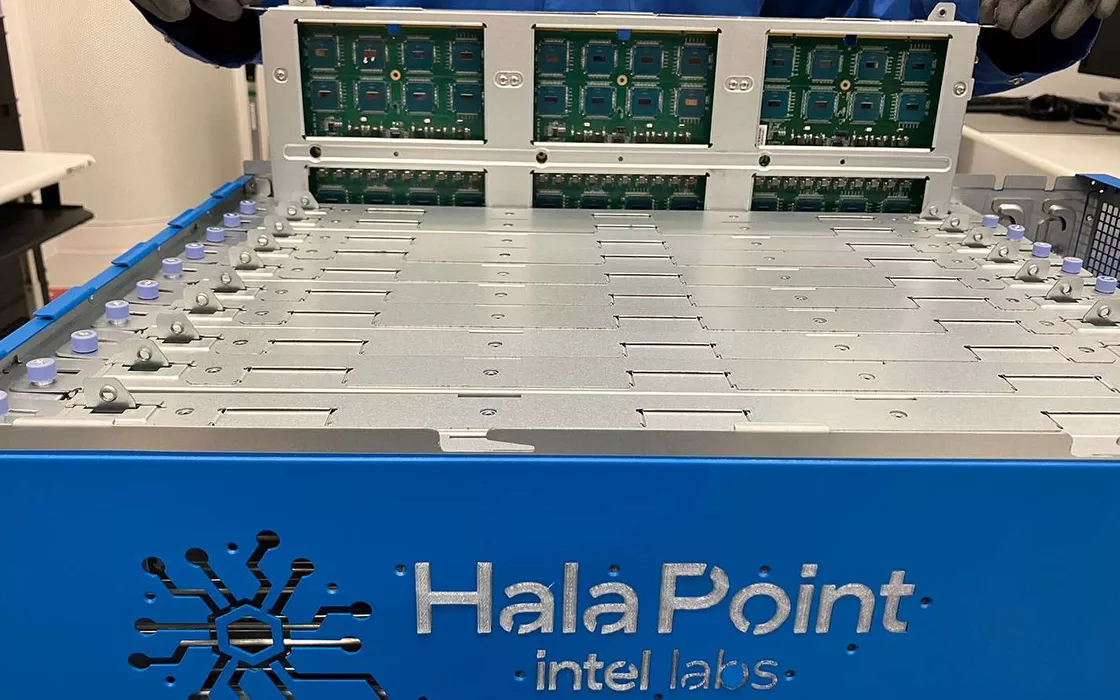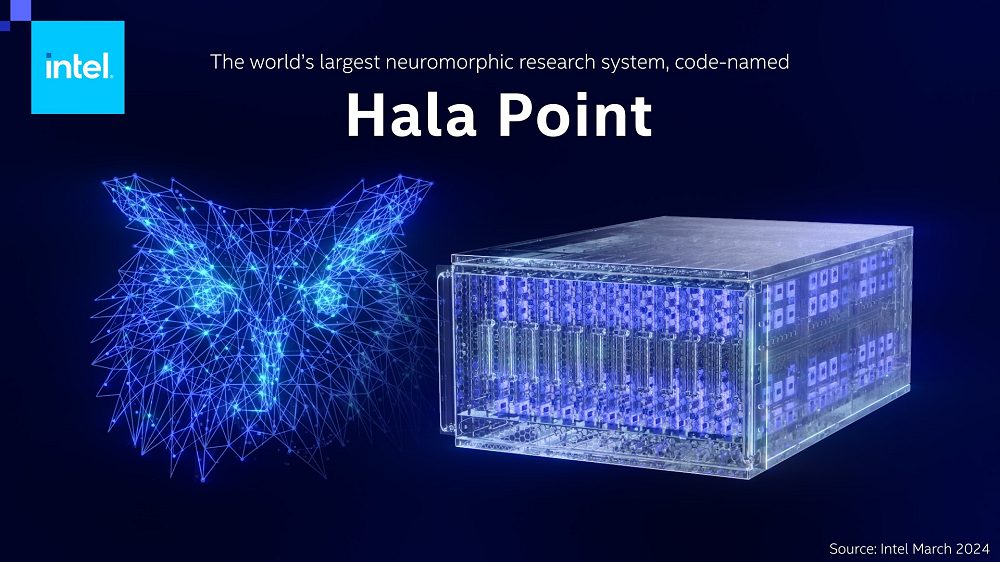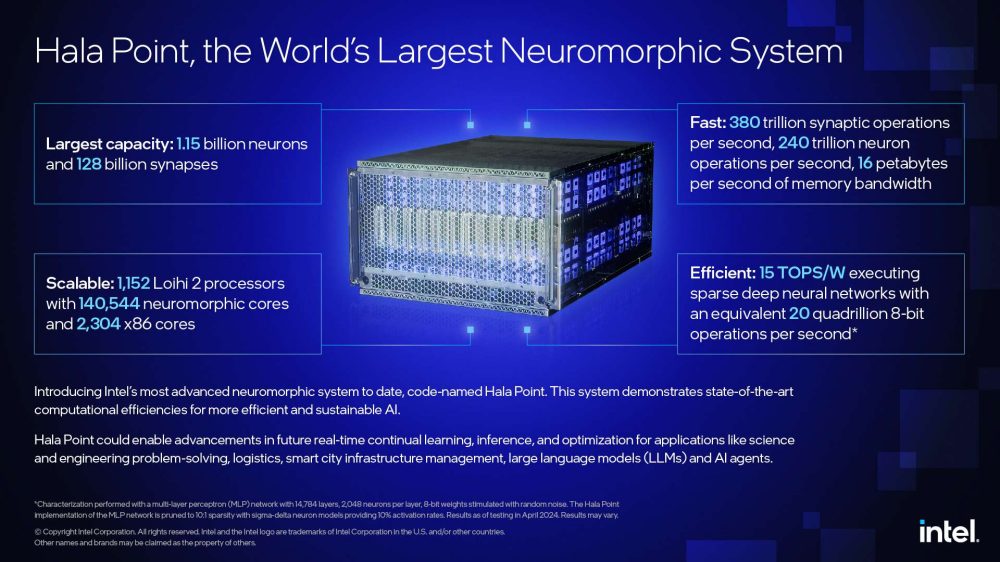Neuromorphic computing, we have already talked about it in another article, is an innovative field that deals with developing hardware and software inspired by the functioning of the human brain and nervous system. This discipline is inspired by neuroscience to design computer systems that emulate the cognitive abilities of the human brain, such as the recognition of pattern, decision making, learning and other advanced features. It fits into this framework Hala Pointpresented by Intel as the largest neuromorphic system in the world.
The idea is to replicate on an IT level the operating methods of the neurons and of synapses, so as to create more efficient and powerful systems to perform certain tasks, such as speech recognition, image processing, robotics and other applications. L’neuromorphic computing aims to overcome the limitations of traditional computers, designing architectures that are more suitable for certain types of problems.
Intel Hala Point: what it is and how the neuromorphic system that wants to make artificial intelligence more sustainable works
Using the innovative processor Long Intel 2, the company led by Pat Gelsinger today announced the construction of the largest neuromorphic system in the world. Hala Point is a system that supports the development of new and more powerful artificial intelligence (AI), inspired by the structure and functioning of the brain.
Mike Daviesdirector of Neuromorphic Computing Lab of Intel Labs, notes that the cost in terms of computing power and therefore electricity consumption of current artificial intelligence models is increasing at unsustainable rates. He also recently talked about it as CEO of ARM, Rene Haswhich did the math on the energy consumed by modern generative models.
As Davies explains, it is not possible to continue on this path. The industry needs fundamentally new approaches that enable the scalability of AI solutions. “That’s why we developed Hala Point, which combines the efficiency of deep learning with new brain-inspired learning and optimization capabilities. We hope that research with Hala Point will lead to breakthrough breakthroughs in the efficiency and adaptability of AI technology at scale“.
The research is still under development, but it is believed that the future Large Language Models (LLM) neuromorphic could lead to gigawatt hours of energy savings eliminating the need for periodic optimizations due to dataset with a continuously growing volume.
How powerful is Hala Point: 1.15 billion neurons
Hala Point is the first neuromorphic system at scale to demonstrate advanced computational efficiencies on leading AI workloads. Characterization shows that it can support 30 million billion (quadrillion) of operations per second, or 30 PetaOPSwith an efficiency exceeding 15 trillion operations per second per Watt (TOPS/W) when running conventional deep neural networks.
Hala Point integrates computation, memory and communication channels into one massively parallelized structure, providing a total of 16 petabytes per second (PB/s) of memory bandwidth, 11 PB/s of inter-core communication bandwidth, and 5.5 TB/s of memory bandwidth. The platform can process over 380 trillion 8-bit synaptic operations per second and over 240 trillion neuronal operations per second.
The result achieved by Intel engineers exceeds the levels achieved by traditional GPU and CPU architectures. Thus, thanks to the exclusive capabilities of Hala Point, it is possible to pave the way for future innovations in the field ofcontinuous learning (continuous learning) in real time. This is in the context of applications called upon to solve scientific and engineering problems, in the field of logistics, management of smart city infrastructure, in the LLM segment and in general of AI-based solutions.
The researchers of Sandia National Laboratories they plan to use Hala Point for the advanced computer research. The organization will focus on solving scientific computing problems related to device physics, computer architecture, and the computer science discipline in general.
Loihi 2 neuromorphic processors
The beating heart of Hala Point are the Loihi 2 neuromorphic processors: they apply computing principles inspired by the brain, such as reti neurali spiking (SNN) asynchronous and event-based, integrated memory and compute, and continuously evolving sparse connections, to achieve orders of magnitude improvements in energy consumption and performance. Neurons communicate directly with each other rather than communicating through memory, reducing overall energy consumption.
Hala Point rests its operation on well 1.152 processors Length 2 in one chassis for data centers with six rack units the size of a microwave oven. As mentioned above, the system supports up to 1.15 billion neurons and 128 billion synapses spread across 140,544 neuromorphic processing cores consuming a maximum of 2,600 Watts of power. The system also includes more 2,300 x86 processors for auxiliary calculations.
While i Sandia National Laboratories expect to take advantage of the benefits of Hala Point soon, Ericsson Research is already using Loihi 2 processors to optimize the efficiency of telecommunications infrastructure, as emerged during the Mobile World Congress of this year.
Loihi-based systems can in fact perform theAI inference and solve optimization problems using 100x less power, at speeds up to 50x faster, than conventional CPU and GPU architectures.
Neuronal capacity similar to that of a monkey or an owl
A system like Hala Point, applied to biologically inspired neural network models, can perform to its full capacity of 1.15 billion neurons, 20 times faster than biological speeds in real time.
Furthermore, although Hala Point is not meant for the neuroscientific modelingits neuronal capacity is approximately equivalent to that of the cerebral cortex of an owl or a capuchin monkey.
Future developments will allow neuromorphic computing applications overcome the power and latency constraints that limit the deployment of AI capabilities in the real world and in real time.
Furthermore, thanks to the cooperation of an ecosystem made up of over 200 members (Intel Neuromorphic Research CommunityINRC), including leading academic groups, government labs, research institutions and companies around the world, Intel is working to push the boundaries of brain-inspired AI and advance this technology from prototype research to actual realization of leading commercial products of the sector within a few years.
The images in the article are taken from Intel’s announcement.



